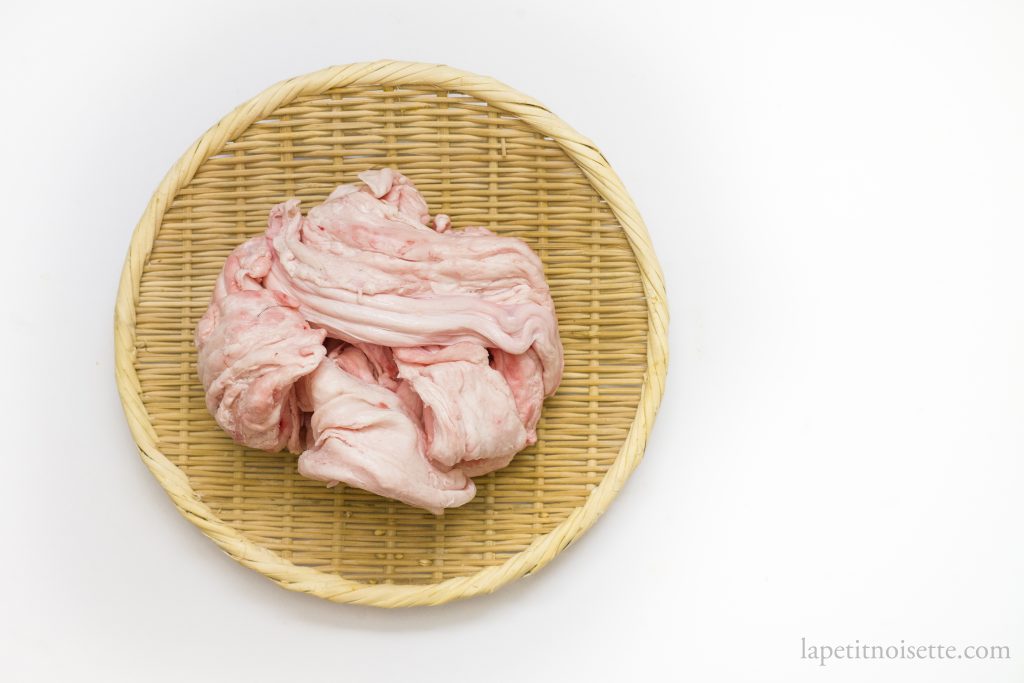
Narikura’s Tonkatsu Recipe とんかつ 成蔵 (なりくら) の作り方
Of all the famous tonkatsu restaurants in Tokyo that I’ve tried, none of them come close to that of Narikura’s snow white tonkatsu. In my opinion, his fried pork is one of the most ethereal foods in existence and is a showcase to Seizo (Narikura) Mitani’s (三谷成藏*) strive for perfection through constantly experimenting and attention to detail. If I were to describe his cooking, I would say what he serves can no longer be described as tonkatsu but his own interpretation of fried pork, which is named tonkatsu only because that’s the closest description for it. This post is an attempt to elucidate Narikura’s perfect tonkatsu recipe based on extensive experimentation.
*The characters ‘成蔵’ can be read as both Narikura and Seizo.
A note on pig breeds and cuts of pork
Most specialty tonkatsu restaurants put a great emphasis on the breed of pork they use, which cuts they serve, as well as the method used to age the meat. We’re going to ignore that for the purpose of this article, as it’ll be unlikely that you’ll be able to obtain the pork they use. Instead, we’ll focus on the pure technique for making an incredible tonkatsu. You should focus on getting the highest quality pork available where you live, preferable from a farmer’s market or butcher. This recipe calls for deboned and skinned pork loin, known as the rosu (ロース) cut in Japanese as well as the fillet/tenderloin (hire/ヒレ) which Narikura himself is famous for.
What is tonkatsu and how is it usually made?
If you’re here you’d know that tonkatsu is deep fried pork that has been coated with flour, egg and bread crumbs. When you typically google tonkatsu the images you get are usually of relatively thin pieces of pork with a rather brown bread crumb coating. This is the bog standard tonkatsu you’ll find at a school canteen or at home and has its reasons of course. A thin piece of pork is easier and faster to cook compared to a thick piece. It will also cook through at the typically used oil temperature of around 160ºC to 170ºC, which is around the same temperature as tempura. If the pork was any thicker, the outside bread crumb coating will burn before the pork completely cooks through. This temperature is the conventional temperature at which internet recipes call for you to fry tonkatsu, which you can tell from the brown bread crumb layer caused by the caramelisation of the sugars in the bread crumb from the high temperature. A thinner piece of pork is also cheaper and more accessible for people to buy because most supermarkets sell pork sliced quite thin, which you can then pound with a meat hammer to flatten out. Most of these internet recipes aim at being simple and economical and are optimised for making a cheap piece of pork nice and tender.
If you look at the more famous restaurants like Tonkatsu Tonta, Marugo or Butagumi, you’ll see that they serve thicker cuts of pork that have not been pounded with a meat tenderizer whilst also having a more golden coloured bread crumb layer instead of a brown one. These restaurants will use higher quality pork that is more tender and also have the experience of perfectly cooking pork thus removing the need for tricks such as hammering the meat or using thin cuts because they are able to fry and rest the pork just as you would with a piece of steak, where at the end of the resting period, the pork is perfectly cooking. This also explains the golden bread crumb texture because it isn’t overly caramelised.
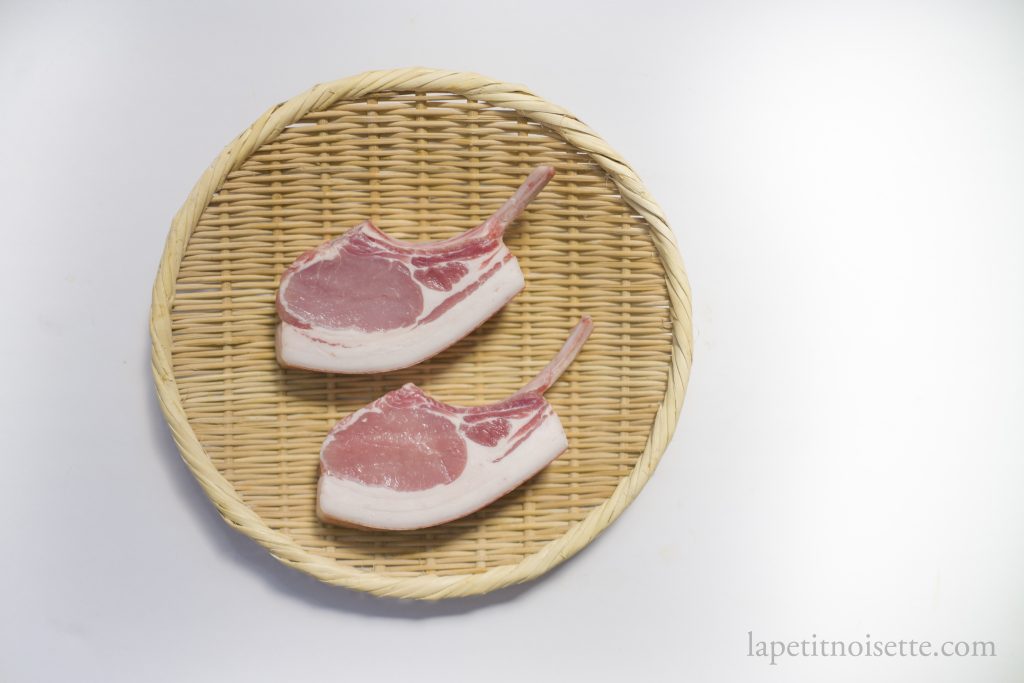
Why is Tonkatsu Narikura different?
The first thing that strikes you about Narikura’s tonkatsu is its colour. It’s neither brown nor golden but an almost pure white colour, as though they’re still raw and they’ve never been fried. The breadcrumbs also appear more puffy as though they’re facing outwards from the tonkatsu, not patted down. When you bite into it, you get this initial crunch, right before the breadcrumbs melt away and you get a brush of pork flavour.
When it comes to famous tonkatsu restaurants, perfectly cooked pork is a standard that can be pretty much taken for granted. What sets narikura apart from the pack is how he obtains this divine coating of bread crumbs, which will dive down into more details below. But first we need to explore:
The science of frying tonkatsu
Whenever it comes to the science of deep frying, the people that have done the best job investigating this have to be the Modernist Cuisine set of books. However these books focus predominantly on deep frying with a thick batter in the context of western fried chicken, and say very little about the Japanese deep frying. In my article on making the perfect tempura, I elaborate on how the same principles of deep frying can be transferred from thick battered fried chicken to thin quick fried tempura. Here we’ll see how the very same principles translate over to a whole different style of frying- tonkatsu frying.
When you deep fry a piece of food in oil above 100°C, it causes the water inside the food to start boiling. As the entire piece of food is submerged in oil, the steam from the water boiling has nowhere to escape other than to leave the food through the batter in streams of bubbles.
This is the bubbling of the food you see when you first add food into the oil.
In fact, the key insight here is that because water has a maximum temperature of 100°C, the steam trapped by the batter is actually cooking the food inside whilst the batter on the outside is being fried. This means that a perfectly deep fried piece of food is actually perfectly steamed on the inside because the temperature doesn’t exceed 100°C and perfectly fried on the outside. Now when it comes to tempura, this process happens very quickly for a few reasons. First, ingredients used in tempura are all prepared thinly, so that they have a large surface area to volume ratio. This combined with an extremely thin batter and temperatures around 160ºC to 170ºC means that heat penetrates the tempura very quickly.
Compared to your bog standard tonkatsu that’s fried at a similar temperature, that explains why most recipes call for a thin cut of pork that you pound thin with a meat tenderizer. It allows the tonkatsu to cook faster at such a high temperature. However, there’s a reason why tempura ingredients are typically fish and vegetables because meat takes significantly longer to cook. In order to completely cook the pork in tonkatsu, you need to be frying at the same high temperatures for longer, which explains the brown coloured bread crumbs on most internet tonkatsu pictures- the bread crumbs have been over caramelised to ensure the pork is cooked through. This isn’t helped by the additional fact that the breadcrumb batter layer is already thicker compared to tempura batter and so slows down heat transfer and the cooking process.
At tonkatsu specialty restaurants, the need for thicker cuts to accentuate the quality of their pork means that they’re forced to lower the temperature of their oil to prevent the bread crumbs from burning. This calls for longer frying times and a greater skill to judge when the pork is cooked just right, before it’s taken out of the oil to rest and finish cooking from its own residual heat. These temperatures are typically lower than 170ºC and go down to about 145ºC.
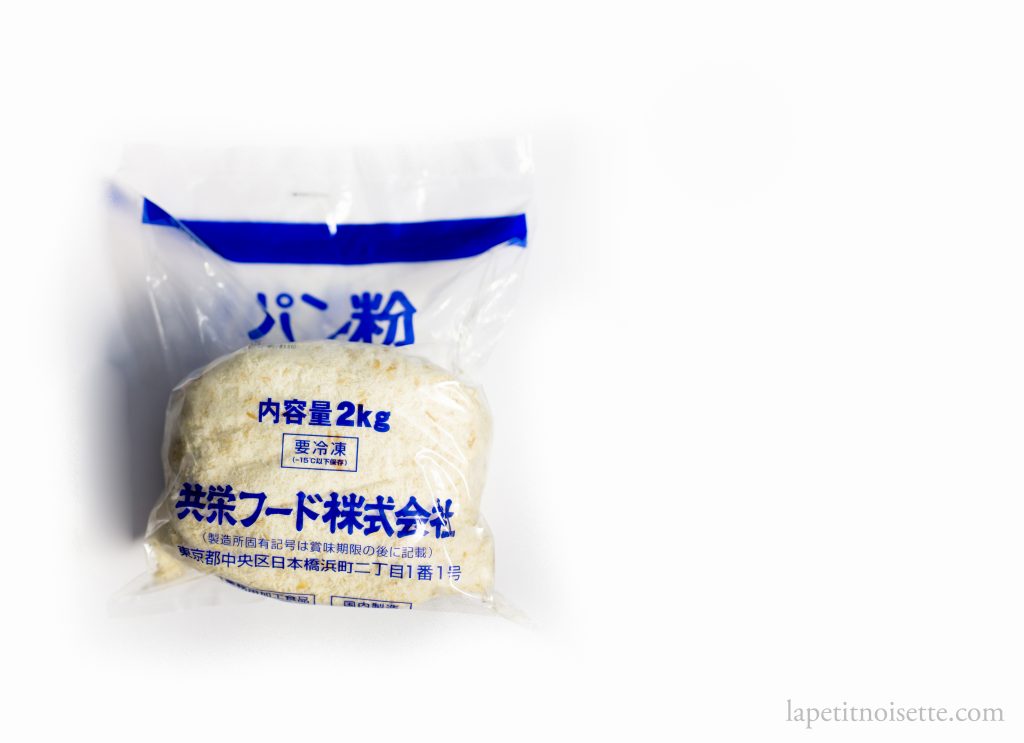
How is Tonkatsu Narikura different from everyone elses?
The mind boggling thing that Seizo Mitani 三谷成藏, Narikura’s owner and chef, does is that he fries his pork at an extremely low temperature of 110ºC to 135°C. To show you how crazy that is, let’s get back to the science.
The whole premise of deep frying food in oil is that it’s above 100°C so that the water inside steams, which leads to the stream of bubbling coming out of the food when you deep fry it. These bubbles have nowhere to escape except through every ceviche and hole in the batter which acts as outward moving propulsion and prevents the oil from penetrating the food and making it oily. If you go any lower, the water in the food doesn’t even boil and you’re just soaking/confiting your pork in oil with the batter slowly, yielding a disgusting oily and impossible wet and soggy batter. There’s a reason why French duck confit is not battered.
At higher temperatures of 170ºC the water is evaporating quickly and bubbling during frying is vigorous. There’s no way any oil is being absorbed by the food. The key insight here is that because water has a maximum temperature of 100°C, the steam trapped by the batter is actually cooking the food inside whilst the batter on the outside is being fried. This means that a perfectly deep fried piece of tonkatsu is actually perfectly steamed on the inside because the temperature doesn’t exceed 100°C and perfectly fried on the outside as the bread crumb layer is exposed to higher oil temperatures.
As you gradually lower the temperature however, the bubbling gets less and less vigorous, almost to the point of danger where there are not enough bubbles to prevent the batter from absorbing oil. At 110ºC, Seizo Mitani has pushed the temperature to the absolute lowest limit, as if you go any lower you won’t have enough bubbles to prevent oil absorption.
This ridiculously low cooking temperature has multiple effects on the tokatsu. For one, the bread crumbs on the outside are so gently fried that they barely caramelise, thus explaining their snow white colour that are his claim to fame. In fact, they’re just so gently fried that they give you the perfect crunch, before melting away in your mouth. Secondly, this low cooking temperature is akin to sous vide pork, where the entire thickness of pork is perfectly cooked to the same degree, instead of being overly cooked on the outer edges. The chef himself claims that at such low temperatures, the bread crumb layer cooks slowly and sticks to the pork instead of puffing up and leaving an air pocket between the pork and batter. It does have its drawback though, the low temperature means extremely long cooking times of almost 20 minutes, limiting the amount of customers he can serve at any one time.
Frying pork at 110ºC isn’t his only technique for achieving absolute perfection, so let’s take a look at what else he does.
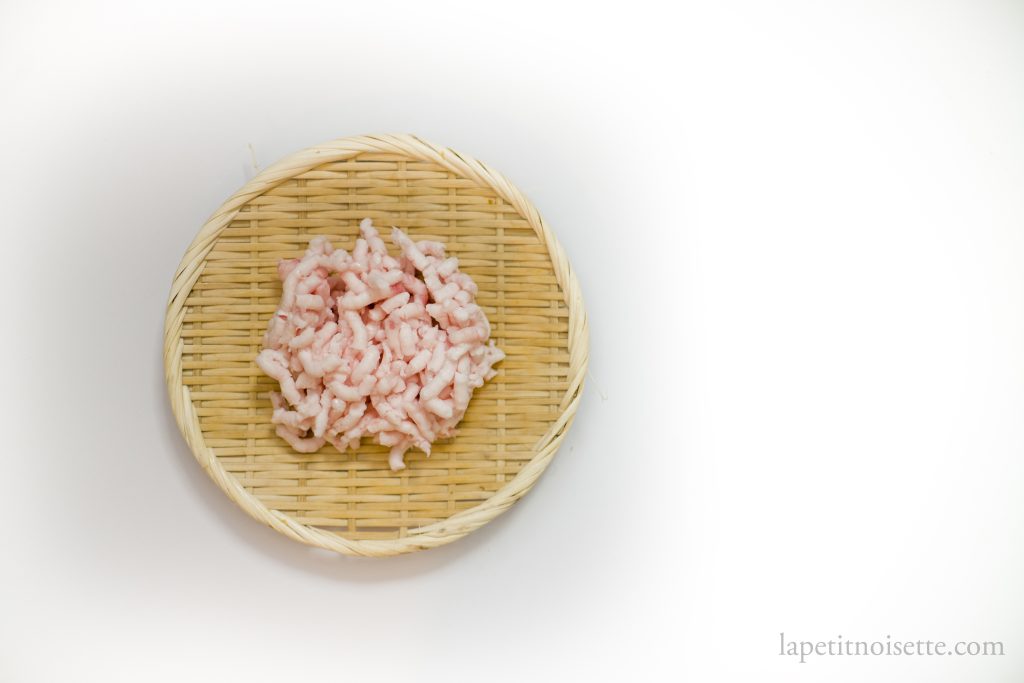
Narikura’s tonkatsu frying details and technique
Leaf lard vs backfat vs oil
An important part of deep frying is the selection of oil you use. Most tempura chefs will pride themselves on their unique house blend of oils they use. Narikura is no different. Instead of oil, the chef prides himself on only using lard to fry his tonkatsu. This is an important point flavour wise as it maintains the purity of the pork’s flavour. Actually, the best example of how superior deep frying using animal fats is compared to vegetable fats has to be McDonalds, who’s claim to fame during their very beginnings was frying their french fries in beef tallow (give it a google it’s a really interesting story).
In true perfectionist style, Narikura doesn’t use any pork lard but insists on using, quote: ‘内臓を包む腸間膜油’, which translates to the mesenteric oil that wraps the internal organs. While there’s no way to verify this, I took this to mean leaf lard or flair lard, which is lard rendered from the fat that surrounds the pig’s kidneys. If you’re from the baking world, you’ll know that this type of snowy white lard has already been long prized for making the very best pastry crusts, and is highly sought after as each pig produces relatively small amounts of leaf lard compared to backfat. In my personal experiments using leaf lard, the resulting tonkatsu was far superior to any tonkatsu fried using vegetable oil when tasted in a blind taste test. Your best way to obtain this is to ask your butcher to keep it for you but you’ll ultimately have to render it down yourself.
He also gently heats up the fat to temperature rather than heating it up on high and then letting it cool in order to prevent the oxidation of the lard. One of the reasons that he claims to use leaf lard instead of normal backfat is because it has a higher melting point of 43–48 °C compared to 30–40°C for backfat and thus has a higher heat capacity and will continue to cook the pork more while it’s resting. This is almost impossible to verify without specific equipment and while the melting point of backfat vs leaf lard is available on the internet, the specific heat capacity of each fat is not something I could find, even when looking through some academic papers. One thing I’m certain of however, is that there is no relationship between melting point and specific heat capacity. He also claims that leaf lard is also less viscous (さらり) compared to backfat when heated, which allows it to drain better from the pork during the resting period after frying, yielding a less oily tonkatsu.
Panko breadcrumbs パン粉
Whilst panko is known in English as Japanese breadcrumbs, they have distinctively different characteristics. Normal breadcrumbs are made from toasted bread that has been crumbled or ground down into small pieces. In contrast, panko bread crumbs are made from non-toasted Japanese bread that have been ground up and dried into flakes instead of crumbs. These flakes are what give tonkatsu its typical light and airy crunch after being fried.
When made on an industrial scale, panko is made using machinery and techniques that are beyond a home kitchen, making it hard to replicate yourself. Even the bread crumbs that Narikura uses have been custom made to his own specifications by a company known as Kyoei foods (共栄フード). His panko has a quarter of the typical amount of sugar added, which combined with the low frying temperature gives rise to his snow-white coating on his tonkatsu as there’s very little sugar to caramelise and brown.
The key point about the breadcrumbs that he uses to coat his tonkatsu is that they’re fresh breadcrumbs, not the dried breadcrumbs you’ll usually find outside of Japan. When it comes to panko freshness, most of us buy our panko from the dried section of the supermarket. However, it’s possible to find something called raw panko (nama panko/生パン粉) that hasn’t been fully dried. As the remaining moisture content takes some time to be evaporated out during frying, it allows you to fry your tonkatsu for a longer period of time before browning occurs. Remember, so long as there is water in the panko, the panko cannot exceed 100ºC, only once all the water is evaporated can browning start to occur.
Whilst it’s impossible to get our hands on the panko he uses, you might be lucky enough to source the standard breadcrumbs that Kyoei foods make. After some digging around, I did manage to find a source of Kyoei foods breadcrumbs that I used to test this recipe. From some playing around, the two biggest factors that influence the quality of panko in my opinion are the flake size and freshness of the panko. You’d want big and flaky panko giving it a light airy crunch when you bite into it. Due to the manufacturing process, raw panko is larger in size than your bog standard dried panko. Panko that’s smaller in size just gives you a crumbly mouthfeel instead of the flaky crisp bite you’re looking for. I’ve even heard of some chefs who sieve their panko to remove smaller sized pieces.
So where does that leave us? Your best case scenario is if you can find raw panko if you live in a big city with a specialty Japanese grocery store (check the fridge or freezer section). If not, a typical asian grocer sometimes stocks 2 or 3 kinds of panko bread crumbs in the dried goods section, so have a look at the packaging and choose the one with the biggest flakes of crumbs. Some of the packages I’ve seen labelled as panko contain something more similar to breadcrumbs inside them. Whilst these bread crumbs are not raw as they’ve already been pre-dried, there is a technique floating around online where you use a mist spray to gently hydrate the breadcrumbs so that they’re more similar to raw breadcrumbs. I personally have not had the chance to try this technique, and will update this post if I find that it yields worthwhile results. Alternatively, it’s also tempting to try and make your own panko from scratch by blitzing a table loaf that has the crust removed. There are various recipes for his online but it would be interesting to try and make a table loaf from scratch with a quarter of the sugar (as his custom made panko), and then convert the loaf into panko. This would require a lot of additional work but would be interesting to see the results.
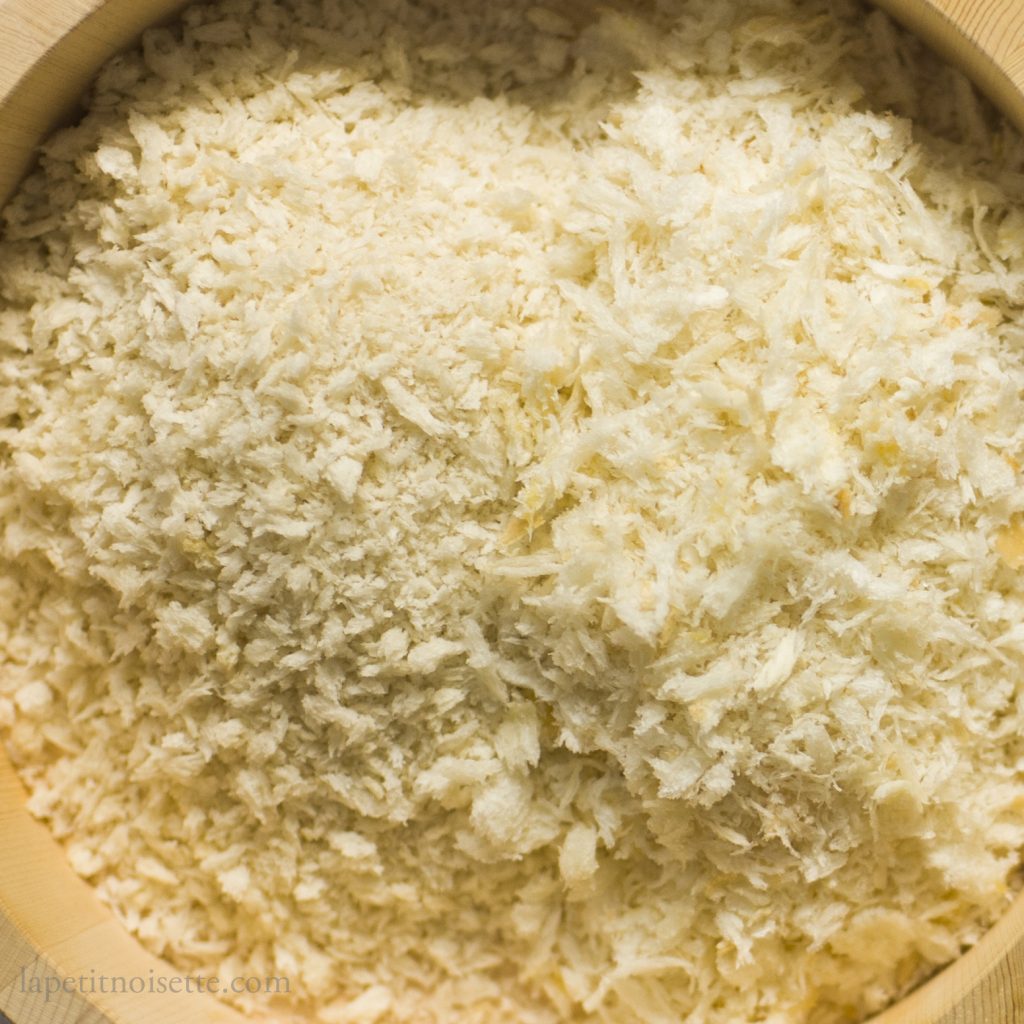
Narikura’s secret technique to applying panko breadcrumbs to his pork
So far everything in this article comes from various tidbits of interviews that he’s given over the years as he’s slowly risen to fame. However, there is one secret technique that he has never elaborated on in public which we’ll disclose here, though how we obtained this information will not be revealed.
After being dipped in flour and egg, panko is usually applied to the pork by patting down the panko onto the surface or by pressing the pork onto the panko. This presses down on panko, which causes them to lie flat lengthwise down on the pork. To Seizo Mitani, this did not yield a sufficiently good texture, so he developed a technique he called ‘blooming the panko flowers’ (パン粉の花が咲く). This was his way of applying the bread crumbs diagonally so that they stand up when fried, as opposed to flat. The way he does this is by using his palm laid flat to brush the surface of his deep tray of panko so that they stand up before gently laying the pork on top of the crumbs. He then takes as large a handful of panko as possible and in one motion pressed the panko onto the pork.
Sounds simple right? But to him, this small adjustment to his technique is probably a big deal to him. When you spend many many years trying to perfect a single recipe, it’s normally the accumulation of many small changes that lead to the perfect result. While it might seem like a simple technique, it could very well have taken him a long time to develop.
Let’s elaborate more why this technique works. First, ruffling the surface of the tray of panko to make them stand up. A simple action but if you’d think about it, slivers or flakes of breadcrumb are just going to naturally lie flat due to their shape. You’d never expect to see a bowl of cornflakes where all the flakes are standing up. But because panko is soft and light enough, by ruffling the surface of the panko just as you would ruffle a dog’s fur, you can get them to stand up. You then lay your pork onto the panko, but instead of pressing the pork down into the panko, you take a handful of panko and use that to press the pork in. That in itself is already interesting. Firstly by using a deep tray of panko, when the bottom layer of panko is pressed downward by the pork from the top, this panko is being pressed into a large cushion of other panko and isn’t being pressed into the hard bottom of the tray. A good analogy here is to imagine pushing a watercolour paint brush against the table versus pressing it against a cloud of cotton candy. The table will force the hairs of the paint brush to flatten out. If you use a shallow tray of panko, even if you were to ruffle the panko to make it stand up, the moment you pressed the pork into the panko, the panko would press against the bottom of the tray and flatten out again. He prevents this by having a large cushion of panko underneath. In addition to this, he takes a handful of panko to press into the pork meaning that the top layer of panko being applied to the pork is still standing up (given that he ruffled it previously) and that the pressure being applied to the panko under the pork is even more gentle. Imagine it like pressing down a chopping board on top of a pillow versus pressing a pillow into another pillow.
We’ve gone to all this trouble to try and analyse this very simple technique. Does it make or break the final tonkatsu we’ll produce? No, I’d say that the difference is minimal at most. However, when taken together with the attention to detail of every single aspect of tonkatsu making, in aggregate they lift his tonkatsu above the rest.
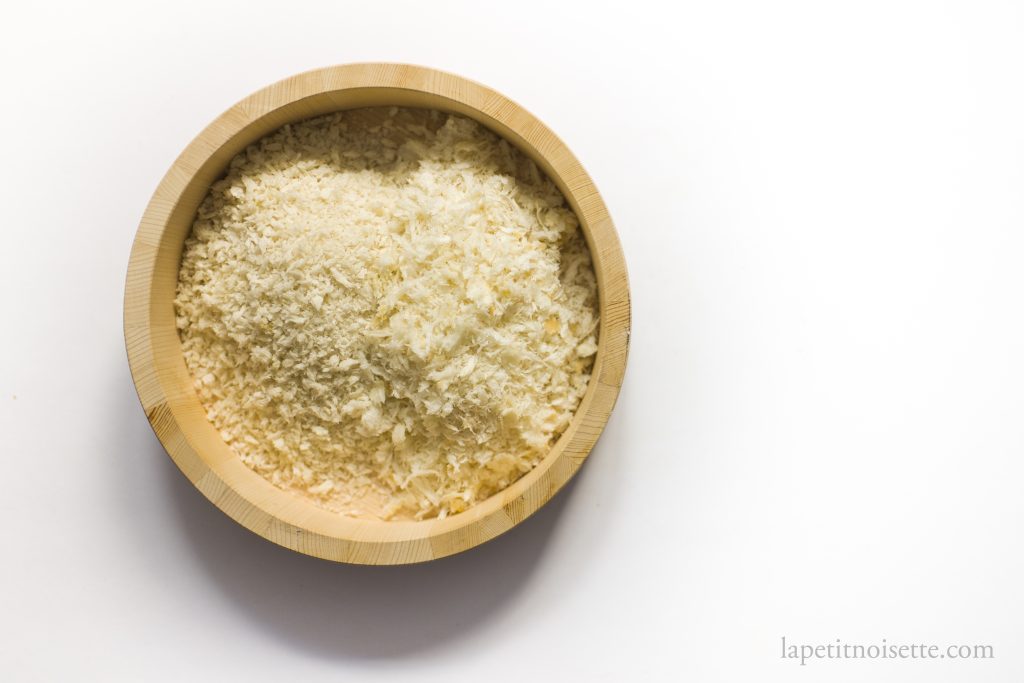
What is Narikura’s tonkatsu frying set-up
The deep frying set-up at his shop is fairly simple, with two 33cm cooper frying pots (純銅揚鍋) heated using two fire stoves. The copper pots are made by tsubame sanjo (燕三条), a company recognisable by the swallow imprint that they stamp onto all their pots. This allows them to fry up to 4 pieces of tonkatsu at any one time. After breading the pork and placing it in the oil, he handles the pork with a pair of long moribashi chopsticks before removing the pork and allowing it to rest standing up on its sides on a wire rack for the excess lard to drip off.
What tests have been carried out?
When carrying out the numerous tests to find the perfect low temperature fried tonkatsu, we decided to start from a higher temperature and then slowly work our way down to lower temperatures and see if we could get to 110°C. We did not, however, try a few things common in the deep frying world as we were trying to replicate his frying process. We did not double fry the tonkatsu korean fried chicken style, and we did not double coat the pork with bread crumbs and eggs, we only applied the breadcrumb coating once. In terms of lard, we ordered our leaf lard from the butcher and rendered it down ourselves. Every new day’s test was done with a fresh batch of leaf lard. None of the pork cuts we used were salted and were allowed to come up to room temperature before frying. The pork was coated in a thin and even layer of potato starch, before being dipped in mixed eggs that had been run through a sieve. This was then immediately transferred to the breadcrumbs to be coated and fried. Once fried, the pork was then allowed to rest for 5 minutes. Eventually we did get down to 110°C and while the the pork did come out perfect, the breadcrumbs where a light yellow in colour instead of a white colour, as even though we were using Kyoei food’s breadcrumbs, it wasn’t the same made to order ones he used that have reduced sugar content.
But speaking of temperature, it turns out that there were a few caveats that we didn’t expect. Firstly, when Narikura talks about oil temperature, he seems to be talking about the oil temperature in the pot itself as though you’d stick a thermometer directly into a clear patch of oil. Instead, to be more accurate, we constantly measured the temperature of the pork in various places. What we found was that the temperature of the oil was always lowest at the face of the loin facing upwards. This made sense as this was where the layer of oil between the pork and air was thinnest. Furthermore, the large cut surface of the loin was where the most water evaporation occurs, thus lowering the oil temperature the most. It was also very noticeable that if the pork dipped below 100°C for too long the resulting tonkatsu would be slightly soggy with oil but if left long enough at a temperature above 100°C it would gradually crisp up again. This was important when experimenting at the lower temperature. For example, when frying pork loin at 135°C oil, the instant you drop the breaded pork into the oil, the sides of the pork loin would measure at around 125°C and the top of the loin would measure at around 115°C for a few minutes even though the oil maintained a constant 133°C to 135°C. After a few minutes of frying however, it would gradually go back up to 135°C. This wasn’t a problem as the oil never went below 100°C. However, when starting with oil at 115°C, the top of the loin would measure at around 90°C for a few minutes before climbing back to a constant 115°C. This would happen even if you used a large amount of oil to maintain the constant oil temperature of 115°C, in the end the area around the pork would still drop in temperature. This meant that there was always a temptation to raise the heat the moment the pork was dropped in or to drop the pork in at a higher temperature so that it drops to just the right temperature. From our experience this doesn’t work as the pork always ends up at a higher temperature than the target temperature as the oil contains enough heat energy to raise the temperature of the pork back to the original temperature. What was lacking instead was giving the pork time to come back up to equilibrium. If you add the pork to oil that was at a higher temperature, given enough time the pork will reach that temperature despite the initial temperature drop. For the Iwatani gas stove we used, we found that we got the best results if we set it to the lowest flame possible which was just enough to maintain the temperature at 115 °C, drop the pork in and let the temperature around the pork drop before waiting for it to come back up to temperature.
Best bets for low temperature fried Tonkatsu (target internal temperature is 62°C to 65°C):
For a 2.5cm thick loin:
155°C for 5 minutes 30 seconds
145°C for 6 minutes 30 seconds
135°C for 8 minutes 30 seconds
125°C for 10 minutes 30 seconds
115°C for 12 minutes 30 seconds
For pork tenderloin:
115°C for 9 minutes
To set up, start by trimming off any excess fat from the pork and allowing the pork to come to room temperature. Beat some eggs to mix the yolks and white together before straining through a fine mesh strainer to remove the chalaza. Prepare a tray of potato starch or cornstarch and a tray of panko bread crumbs. Once the setup is prepared, Heat enough leaf lard in a pot to fully submerge the pork. Using the palm of your hand, brush the surface of your panko so that they stand up. Dry the pork using kitchen towels before coating the pork well with potato starch. Submerge the pork into the egg mixture before gently laying the pork on top of the crumbs. Then, take as large a handful of panko as possible and in one motion pressed the panko onto the pork. Once the lard has reached your desired temperature, gently submerge the pork in the lard and slowly fry for the required time, flipping the pork once halfway through. Once cooked, remove the pork and place sideways on a wire rack to fully drain the excess lard. Allow to rest for 5 minutes before cutting.
The tonkatsu at Narikura is served with pork soup, shredded cabbage and a choice of pickles. The rice he uses is koshihikari rice (こしひかり喜左衛門) by a company known as Kyoto Yuki in Yosano Town, Kyoto. He also has a bottle of sesame seed oil for you to add from Isomura Masajiro Shoten (まさじろうさんの胡麻油).
It has always been a dream for me to go to Narikura to eat but sadly Japan isn’t fully open to tourists yet! Thank you so much for managing to go so in depth into the cooking methods of all these renowned restaurants!
I had the humble honor of waiting 3 hours in line on a rainy Tuesday for his tonkatsu. Tldr: Worth it.
Great write up as usual! Narikura is an amazing shop. I was under the impression they must sous vide their meat before frying (like other large-cut shops), but the truth is far more impressive.
Some notes based on my Tonkatsu experiences:
For me, I found the breading at Narikura to be “pastry-like”. This made the Tonkatsu quite palate fatiguing in my opinion, especially the fatty cuts. Compare this to Tonkatsu Manger in Osaka, who use similarly thick cuts of pork but fry at closer to standard temperatures. The panko comes out a caramel brown, and the pork still a perfect cook. Manger blew me away, each bite left you wanting more and felt perfectly balanced. The chef there is a bit older and more traditional, but has the same magic.
Some musing about panko:
At home I tend to buy (or bake) shokupan and hand rip shreds to make close to what the special producers in Japan create. This obviously is not scalable past a small dinner party. Food processing the panko to any size makes the pieces round, and while superior to dried panko, does not come close to the long wisps of hand shredding.
Notably, some shops in japan shred their own panko used a smaller desktop version of what the large manufacturers use. I haven’t found an affordable or practical solution to mimic this at home, but I’ll stay on the hunt. Perhaps running thing slices through a noodle cutter?